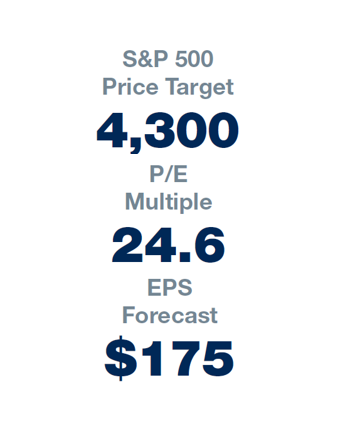Lighting the Path to Normalcy
- February 10, 2021
2021 Market Outlook
With several Covid-19 vaccines in distribution and the Federal Reserve’s decisive policy action lifting markets, the year ahead breeds newfound optimism for investors as we begin to refocus on fundamentals. In their 2021 outlook, our investment experts share their opinions on the financial markets, the economy and asset allocation as well as their implications for investors.

John Stoltzfus
Chief Investment Strategist
Oppenheimer Asset Management
With a new year comes renewed optimism. Two vaccines are in distribution, with more on the way, fueling hope that daily life could return to normal as early as this summer. That sentiment is reflected in major U.S. stock indexes, which posted new record highs in early January. But risks abound in the pursuit of that goal as infection rates remain high, businesses are still shut and unemployment is rising.
However, by soberly assessing those risks and adjusting return expectations, investors can use bouts of volatility that lie ahead as opportunities to buy dips and reposition portfolios. From a policy standpoint, a sharp left turn on taxation and regulation under the Biden administration seem unlikely but cannot be entirely ruled out. The Federal Reserve remains committed to providing liquidity and supporting economic growth, having pledged to keep interest rates near zero for the foreseeable future.
Still, the Fed is expected to slow its asset purchases, roughly $120 billion per month, which could stoke fears of another Taper Tantrum like we saw under Ben Bernanke in 2013. With the spigots of monetary and fiscal policy wide open in support of an economic recovery, inflation concerns are likely to resurface as well. In our view, the probability of a repeat of the double-digit interest rate and inflationary spiral that occurred in the late 1970s and 1980s is deeply remote. In February 2019, even as unemployment hit record lows, inflation—as measured by the Fed-favored PCE deflator—was still running below the Fed’s 2% target, where it had mostly remained since 2012.
For the labor market, now down about 10 million jobs from its year-ago peak, the slack in the economy means that strong wage and price growth seem unlikely. In addition, the shortages of certain in-demand items (household cleaners, used cars and toilet paper) that occurred in 2020 are not likely to be repeated. Instead, we expect an overabundance of commodities and consumer products as well as the fierce competition between suppliers to keep pricing power restrained.
Looking ahead, we believe the market is poised for a period of prosperity akin to the post-World War II era, as pent-up demand for travel and entertainment, fashion and hospitality propel economies worldwide. We remain overweight U.S. equities while maintaining meaningful exposure to developed and emerging markets on expectations that an economic recovery stateside coming out of the Covid-19 emergency will help boost growth and drive global economic expansion.
Among sectors, we continue to overweight cyclicals over defensive stocks, we favor information technology, consumer discretionary, industrials and financials. Our 2021 year-end price target for the S&P 500 is $4,300 based on earnings per share of $175, which assumes a P/E multiple of 24.6 for the next year.


Anusha Rodriguez
Head of OAM Research and OAM Alternative Investments
Oppenheimer Asset Management
In 2021, we believe global long/short equity, eventdriven, private equity and private credit strategies are poised to drive attractive absolute returns and suitably position investor portfolios. Global long/ short equity strategies were able to successfully navigate market volatility in 2020, generating alpha and protecting capital through downturns with active portfolio management. We believe that prudent managers that can generate both long and short alpha across markets will perform well again in 2021.
Additionally, we anticipate that event-driven managers will benefit from an enhanced opportunity set, increased M&A activity and sectorbased consolidation due to Covid-19 disruptions. With depressed valuations, companies across market caps and geographies may now become prime targets for hostile and friendly acquisitions.
With interest rates at historical lows or even negative, private credit strategies may be able to generate outsized returns through more complex strategies while retaining seniority in the capital structure. That includes non-bank lending, convertible bonds and other opportunistic distressed investments.
We’re seeing increasingly attractive opportunities across sectors, with a focus on machine learning, artificial intelligence, enterprise software, e-commerce, consumer and healthcare companies. With global health top of mind, notable advancements in the medical industry have increased awareness and funding for the sector. These developments are translating into high-quality investment opportunities that are worth monitoring.
Elsewhere, we remain bullish on environmental, social and governance (ESG) investing and believe that an allocation to renewable energy and its underlying infrastructure will be particularly attractive for years to come. In real estate, select strategies may provide capital appreciation and yield to investors as various pockets of the asset class recover. Specifically, we see multi-family and industrial real estate outperforming traditional office and retail properties.
Structural change is often a necessity for growth. As we dissect the post-pandemic world, it’s clear that historical methodologies and passive management may not perform as they once did and the traditional 60/40 allocation model may not provide investors with the same return profile of the past. With interest rates around the world at record lows, rising sovereign debt and continued debasement of fiat currencies, reducing exposure to traditional fixed-income strategies may protect against permanent capital impairments.
Overall, we continue to monitor changing market dynamics and investor appetite to provide access to strategies that diversify, enhance and protect capital throughout market cycles.

Chris Barsky
Head of OAM Consulting
Oppenheimer Asset Management
Diversification is more important than ever given current asset valuation levels and the wide divergence of potential market outcomes. We anticipate increased market volatility as stocks enter 2021 with elevated valuations on an absolute historical basis. Global economies and financial markets may be in uncharted territory with record low interest rates and the Fed telegraphing its intention to maintain low rates for the next few years. When discerning investors analyze financial assets in the context of the interest-rate environment, they can uncover attractive value opportunities.
We believe that the clearest risks to continued asset appreciation are inflation and the trajectory of long-term interest rates. Investors should closely monitor whether economic growth normalization in the aftermath of Covid-19 coupled with global central bank monetary expansion leads to a reflationary environment evolving into an inflationary environment. The optimal portfolio for a low but steady growth economy with low and stable inflation is far different than the optimal portfolio for an environment marked by rising inflation expectations and long-term yields. Rather than making a macro bet, investors should seek broader diversification.
Additionally, there were three long-term market trends that reversed course in the fourth quarter: growth outperforming value, U.S. domestic outperforming international, and large-cap outperforming small-cap. Those trend reversals further amplify the importance of diversification, active management and rebalancing as we wait to see if those market shifts persist. Continued momentum or reversals of these trends will likely be driven by the pace of the recovery in the wake of Covid-19 and the effectiveness of central bank responses.
For 2021, we remain optimistic that innovative companies with a commitment to research and development will continue to grow and displace complacent incumbents. Active management remains the first line of risk management against capital impairment, particularly in this segment of the market. In our view, companies integrating ESG principles into their core business models are at the forefront of innovation. We expect these companies to continue to outperform on the strength of their revenue growth and higher cost of capital advantages.
Ultimately, we believe a portfolio that is diversified across styles, market caps and geographies that includes innovative leaders in their respective industries, as well as hedged and diversifying strategies, is well-positioned for 2021.

From top to bottom
Leo Dierckman
Portfolio Manager, Taxable Fixed Income
Oppenheimer Asset Management
Michael Richman
Portfolio Manager, Taxable Fixed Income
Oppenheimer Asset Management
As we look ahead to another new year, the stormy skies may be dissipating. Vaccines are being administered, fiscal and monetary stimulus continues to buoy the economy and there’s a wave of pent-up consumer demand ready to be unleashed as life normalizes. We believe the Fed deserves a round of applause for its heroic actions in 2020. The immediate rate cuts and emergency programs put in place at the outset of the pandemic quickly restored liquidity to markets and spurred a market recovery. If one simply looked at the string of annualized fixed-income returns over the past five years, 2020 would not stand out much, but the intra-year volatility will go down in the history books.
For now, the Fed is on hold. We do not expect rate increases until 2023 at the earliest. The yield curve is certainly low but is favorably sloped, suggesting we have entered a multi-year expansionary period. Given changes to the Fed’s monetary policy framework, the Fed is likely to remain on hold even longer than it has in the past.
We anticipate positive but unpredictable GDP growth in all four quarters of 2021. Much will depend on the speed at which vaccines are manufactured, distributed and administered along with adherence to safety precautions. Look for 2021 GDP in the 3%-4% range as the Covid-19 fog continues to lift.
While a few publicized measures of inflation may intermittently suggest concern, the measure that matters to us (and the Fed) is core personal consumption expenditures. We believe this metric will move back toward 2% over time from the most recent reading at 1.4% in November. We expect unemployment to decline to the 5.5% to 6% range in 2021 from 6.7% currently. Given that the economy was not generating significant levels of inflation at pre-pandemic unemployment levels around 3.5%, we do not expect a sustained surge in inflation.
We expect a modest total return in the low singledigits for investment-grade bonds as corporate spreads are at historically tight levels relative to U.S. Treasury bonds. We still want to take advantage of the extra yield corporate bonds offer over Treasury and agency bonds. On the high-yield front, we anticipate a coupon clipping year with a mid-single digit total return. Our favorite ratings categories remain crossover credits: BBs and select Bs. For the most part, we are on the sidelines with CCC credits.
We anticipate favorable performance from banks and finance companies on the investment-grade front as they benefit from a steeper yield curve during 2021.They should also provide a safe haven for investors given prospects for leveraging across other corporate sectors. We favor select retail and hospitality credits in high yield and REITs as we anticipate they will benefit from pent-up consumer demand.
As long-term investors, we continue to position portfolios to be dependable components of an overall asset allocation. We remain focused on producing income, not overreaching for yield, and taking advantage of opportunities presented by the market.

From top to bottom
Katherine Krieg
Portfolio Manager, Tax-Exempt Fixed Income
Oppenheimer Asset Management
Ozan Volkan
Portfolio Manager, Tax-Exempt Fixed Income
Oppenheimer Asset Management
Despite the challenges municipalities faced last year, investment-grade municipal bonds performed well. Investors looked past short-term revenue shocks and recognized the impact of Fed stimulus. The Fed’s interest-rate cuts, bond-buying programs and new liquidity facilities were instrumental and should not be underestimated. In the spring, when the potential economic impact of the pandemic was first recognized and markets went into freefall, the Fed’s leadership helped stabilize the market, which led to a nascent recovery that appears sustainable. Interest rates on munis are now at levels that seemed unimaginable just a decade ago.
Even with rates at historically low levels in most maturity structures that are below 1%, we believe rates will remain steady throughout 2021. Under the leadership of Secretary of the Treasury nominee Janet Yellen and Fed Chairman Jerome Powell, the market would have strong fiscal and monetary support to maintain low interest rates for the foreseeable future. The Fed has communicated its intention to keep rates low well into 2022 and 2023 and let inflation “run hotter” before tightening monetary policy.
In our view, the incoming Biden administration should be “credit positive” for munis with strong support for state and local governments in the form of direct fiscal stimulus. Nationwide, state and local government revenue has been negatively impacted by the coronavirus pandemic—even as spending needs increased. In fiscal 2020, which ended on June 30 for many states, general fund revenue was down, on average, 2.9%. Thirty-five states reported shortfalls in revenue relative to budget projections.
However, fiscal stimulus in the form of direct aid should help mitigate 2021 revenue shortfalls, bridging the gap until the economic recovery takes hold.
In addition to direct aid, we anticipate that the Biden administration’s top priority will be a bipartisan infrastructure program. The purpose of a comprehensive infrastructure bill will be twofold. First, it will provide necessary stimulus and jobs to a recovering economy but also replace aging infrastructure well past useful life. Within this package, we would not be surprised to see a reinstatement of advance refunding for tax-exempt credits and a new program similar to Build America Bonds.
Further, we envision a possible reversal of the limitation on state and local deductions. The 2017 Tax and Job Act limited the individual federal exemption on all state and local taxes (including property taxes) to $10,000. This limitation negatively impacted economic growth in high-tax, predominantly Democrat-run states, many of which are the largest contributors to national GDP. A reversal of this limitation could be another growth driver in 2021.
Looking ahead, we’re cautiously optimistic that the next 12 months will steadily bring recovery and an easing of financial pressures for our issuers. For investors, the mid- to high-single-digit tax-adjusted returns in 2020 will be hard to repeat in 2021. With interest rates at historically low levels, additional appreciation will be hard to achieve through a continued decline in yields, tempering return expectations to low single digits. Nonetheless, a steady interest rate environment coupled with credit improvement can provide
Reach out to your Oppenheimer Financial Professional if you have any questions.
Disclosure
© 2021 Oppenheimer Asset Management Inc. This commentary is intended for informational purposes only. The information and statistical data contained herein have been obtained from sources we believe to be reliable. Oppenheimer Investment Advisers (OIA) is a division of Oppenheimer Asset Management Inc. The opinions expressed are those of Oppenheimer Asset Management Inc. (“OAM”) and its affiliates and are subject to change without notice. No part of this commentary may be reproduced in any manner without the written permission of OAM or any of its affiliates. Any securities discussed should not be construed as a recommendation to buy or sell and there is no guarantee that these securities will be held for a client’s account nor should it be assumed that they were or will be profitable. This material contains forward-looking statements and there can be no guarantees that the views and opinions expressed will come to pass. Forward-looking statements are subject to a variety of risks, such as economic, political, and public health, that could cause actual events or results to differ materially from those anticipated in the forward-looking statements and projections. Any results shown are hypothetical and are for illustrative purposes only. Past performance is not a guarantee of future results.
Indices are unmanaged, hypothetical portfolios of securities that are often used as a benchmark in evaluating the relative performance of a particular investment. An index should only be compared with a mandate that has a similar investment objective. An Index is not available for direct investment, and does not reflect any of the costs associated with buying and selling individual securities or management fees. Past performance does not guarantee future comparable results.
Oppenheimer Asset Management is the name under which Oppenheimer Asset Management Inc. (OAM) operates. OAM is a registered investment adviser and is an indirect wholly owned subsidiary of Oppenheimer Holdings Inc., which also indirectly wholly owns Oppenheimer & Co. Inc. (“Oppenheimer”), a registered investment adviser and broker dealer.
Securities are offered through Oppenheimer and will not be insured by the FDIC or other similar deposit insurance, will not be deposits or other obligations of Oppenheimer or guaranteed by any bank or other financial institution, will not be endorsed or guaranteed by Oppenheimer and will be subject to investment risks, including the possible loss of principal invested.
Special Risks of Fixed Income Securities: There is a risk that the price of these securities will go down as interest rates rise. Another risk of fixed income securities is credit risk, which is the risk that an issuer of a bond will not be able to make principal and interest payments on time. Neither OAM nor its affiliates offer tax advice. Liquidity risk is the risk that you might not be able to buy or sell investments quickly for a price that is close to the true underlying value of the asset. When a bond is said to be liquid, there’s generally an active market of investors buying and selling that type of bond. Investments in lower-rated debt securities (rated below BBB and commonly referred to as high yield or “junk” bonds) involve additional risks because of the lower credit quality of the securities in the portfolio. Investors should be aware of the possible higher level of volatility and increased risk of default and illiquidity.
Special Risks of Alternative Investments:There is a substantial risk of loss when investing in alternative investments and, for each specific fund, the risk of underperforming the general markets or other funds. The investor should carefully review the PPM of any fund before investing. Alternative investments are not appropriate for all investors and only may be offered to certain qualified investors. Investors must be able to bear the economic risk of such an investment for an indefinite period and can afford to suffer the complete loss of investment. An investor’s ability to redeem from such investments is limited to specific time periods (eg. monthly, quarterly, semi-annually, annually) with certain notice requirements. With newly formed managers, there may be greater operational and financial risk factors. Oppenheimer & Co. Inc. has selling agreements with the hedge funds on the alternative fund platform. Oppenheimer & Co. Inc. receives part of the management fee and incentive fee and does not receive the same compensation from each hedge fund. This may be a potential conflict of interest for Oppenheimer & Co. Inc. and its financial advisors to recommend funds that pay higher compensation.
The material is not a substitute for consultation with a legal or tax advisor and should only be used in conjunction with his or her advice. Oppenheimer, and its employees